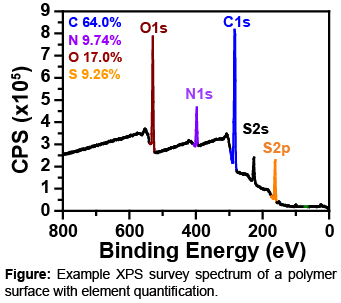SPSE X-ray Photoelectron Spectroscopy
Page Content
The School of Polymer Science and Engineering operates a state-of-the-art ThermoFisher ESCALAB 250Xi X-ray Photoelectron Spectrometer (XPS) designed for fundamental investigation of surfaces and thin films. The XPS analytical facility is accessible to academic, government, and industrial researchers interested in surface and subsurface analysis of materials at length scales ranging from nanometers to micrometers. The acquisition of this XPS instrumentation was supported by a Major Research Instrumentation grant from the National Science Foundation (Award DMR-1726901).
Faculty Contact: Dr. Derek Patton (derek.pattonFREEMississippi)
Instrument Location: PSRC 175
XPS Analysis Request Form (Fillable PDF)
The Faces Scheduling System is used to reserve instrument time on the ESCALAB 250Xi. A Faces account and user name are required to reserve XPS time.
The ESCALAB 250Xi offers multi-technique capabilities including ultraviolet photoelectron spectroscopy (USP), ion scattering spectroscopy (ISS), and reflected electron energy loss spectroscopy (REELS). Additional accessories include an argon ion sputtering system capable of operating in monoatomic (Ar+) or polyatomic (Arn+) modes for depth profiling materials ranging from inorganics to polymers.
Technical Specifications and Features of the ESCALAB 250Xi
Analyzer: Type 180° double focusing hemispherical analyzer with dual detector system for spectroscopy
and imaging.
X-Ray Source Type: Monochromated, Micro-focused Al K-Alpha
Analysis Spot Size: 200 - 900µm (source defined), down to 20 µm (lens defined)
Imaging: Fast parallel imaging with resolution down to 1 µm
Charge Neutralization: Dual-source low energy electrons and ions
Accessories: Monatomic and gas cluster ion source (MAGCIS), UV lamp for UPS, heating/cooling
samples holder for preploc and analysis chambers
What is X-ray Photoelectron Spectroscopy?
X-ray photoelectron spectroscopy, also known as electron spectroscopy for chemical analysis (ESCA), is a technique for analyzing the surface chemistry of a material. XPS can measure the elemental composition, empirical formula, chemical state and electronic state of the elements within a material. XPS is based on the photoelectric effect. An XPS experiment involves irradiating a solid surface with a beam of X-rays while simultaneously measuring the kinetic energy of electrons that are emitted from the top 1-10 nm of the material being analyzed. A photoelectron spectrum is recorded by counting ejected electrons over a range of electron kinetic energies. Peaks appear in the spectrum from atoms emitting electrons of a particular characteristic energy. The energies and intensities of the photoelectron peaks enable identification and quantification of all surface elements (except hydrogen).